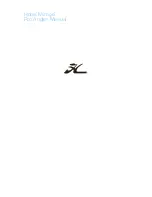
22
5.
THE MAINSHEET WINCH
(fig 24)
5.1 The main sheet winch employs a
friction drum which does not reel up
the sheet, but uses microscopic glass
beads to grip the rope on a single turn.
5.2 If the mainsheet winch is over-
loaded a 10 amp fuse, located on the
winch motor under the console, may
blow. Remove the winch to replace
the fuse. The fuse holder is taped to
the side of the motor.
5.3 Do not tie a stopper knot in the end of the mainsheet. It is better to run the sheet
off the drum rather than have a knot cause a jam and the fuse to blow, or possibly cause
structural damage. See maintenance and trouble shooting to re-reeve and adjust the
mainsheet.
5.4 It is very effective to hang a canvas bag or plastic container below the winch to col-
lect and contain coils of the mainsheet.
6.
THE JIB SHEET WINCH
(fig 25)
6.1 The jib sheet winch employs a friction drum
similar to the mainsheet winch.
6.2 If the jib sheet slips, re-tension the drum by ad-
justing the tension spring (nyloc nut and lock nut on
port side of winch drum shaft), or the rubber bands
are giving insufficient tension. Replace the rubber
bands if they are perished or broken. (The rubber
bands will soon be replaced with springs).
6.3 The jib sheet tail should be tied off at the sad-
dle on the side of the console below the jib sheet
winch. This will prevent the tail end being caught
up in loops of the main and jib sheets.
6.4 Twists can develop in the jib sheet either side of
the winch. Periodically free the sheet and pull the
sheet through the fingers to unravel any twists.
6.5 The red plug lead running forward to the jib winch should be fed above the main
winch and above the main mast reefing drum (see fig 11 on page 13 for a view of what
the reefing drums looks like) and exit on the starboard side of the mast. It then goes
thru the hole in the front of the console and up to the jib sheet winch lead.
Fig. 24
Fig. 25






































